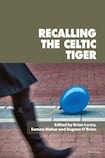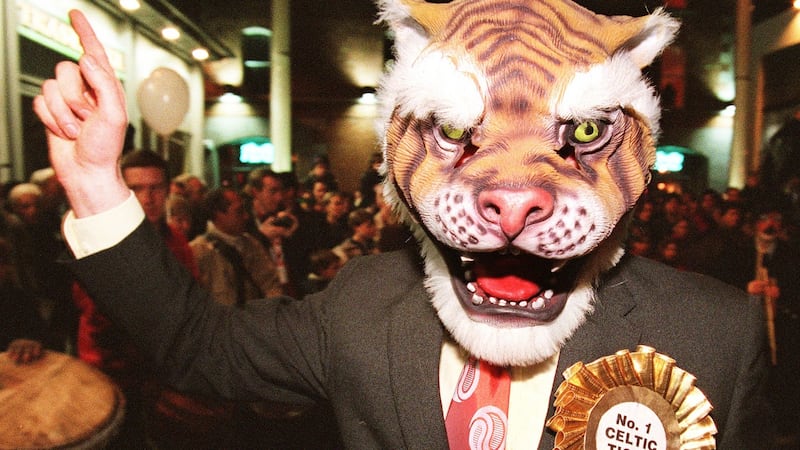
The so-called Celtic Tiger was a dramatic period in Irish history when a troubled and economically backward country suddenly seemed to have discovered Aladdin's lamp and all its wishes came true. It was liberating, exhilarating, self-delusional and ultimately disastrous and we are still living with its dodgy legacy. It left us with a morning-after hangover of €206 billion of public debt – or, if it sounds more cheerful, €42,500 for every person in the State. Its equal and opposite reaction – the years of austerity in which we were supposed to purge our sins by self-flagellation – damaged many lives. Yet it is also strangely veiled in amnesia. It hovers over us like a haze of embarrassment – that mad binge when we made a show of ourselves and that we prefer not to remember in too much detail.
It is not too much of an exaggeration to say that the Celtic Tiger itself was a problem of epistemology – it was about the ways in which a society could fail to know itself. Even the name is problematic. There was nothing Celtic about the long boom in the Irish economy that lasted from 1994 to 2007. And it was not a Tiger economy. The term properly refers to the south-east Asian model of rapid growth that centred on state-led industrialisation. The State was certainly a huge force in what happened in Ireland (for both good and ill) but the boom was largely driven by foreign direct investment by US-based transnational corporations.
More significantly, though, the Celtic Tiger was a phenomenon that very rapidly mythologised itself. It was a result of a very specific combination of factors, from the US tech boom to the long-term impact of feminism in allowing women into the paid workforce (the Irish workforce doubled in this period, while female fertility halved), from inward migration to State investment in education, and from the EU single market to the secularisation of a society in which the Catholic church was losing its institutional power. But all of this complexity was set aside. Instead of Ireland (in all its intricacy) we got “the Irish model”, a grossly simplistic moral to be drawn from this thrilling story of a sudden metamorphosis from economic basket case to star performer of globalisation. The magic lamps, we told ourselves and the world, were those objects of neoliberal desire – tax cuts and “light touch” regulation.
There is still, therefore, a great deal of work to be done in thinking about and describing the rise and fall of this great delusion. The problem is that a full history of the episode would have to be written through so many different lenses: economics, history, politics, religion, culture, gender, social class, media and governance. Someone will eventually do that but until they do we have this brilliantly conceived kaleidoscope of a book, which adopts the form of an A to Z (actually A to W) as a structure in which academic and other experts (ranging from the editors to Karl Deeter, Constantin Gurdgiev, Eimear Nolan, Martina Fitzgerald, Rob Kitchin, Megan Greene, Ruth Barton and a dozen others) present superbly succinct, accessible and clearly-written mini-essays.

Wonderful vignettes
The great advantage of this form is that it mirrors the crazily jumbled-up feeling of the period itself, in which unlikely juxtapositions were of the essence. (Carmen Kuhling and Kieran Keohane captured this in their fine 2004 book Collision Culture.) The encyclopedic structure, like the Celtic Tiger itself, gives the illusion of control while being almost surreally eclectic. The alphabet runs amok by placing Kitchin on ghost estates next to John Mulcahy on gastro-tourism and Eamon Maher on golf clubs; taking us on a vertiginous slalom from contracts for difference to craft beer to credit default swaps; putting wine culture beside women and the church; and crashing Gurdgiev on the Anglo Irish tapes into Ahern, Bertie epitomised by Sean Barrett.
There are some wonderful vignettes along the way, a particular highlight being John McDonagh’s splendidly sardonic essay on the “ubiquitous electric gate, complete with neon-blue intercom and keypad, that became the ultimate symbol of the property-addicted Celtic Tiger arrivistes. Like a contemporary version of the Star Trek swooshing doors, the electric gate embodied the pretentiousness of required privacy as well as technological savvy, bequeathing the owner with an aura of social importance and monetary wealth”.
There are occasional lapses of editorial judgement, particularly where the chosen author is too close to officialdom – whoever thought that the minister for finance, Paschal Donohoe, was best placed to write the entry on public finances showed, shall we say, a certain naivety. Does he mention that €206 billion debt hangover? No. He delivers an ardfheis speech: we must "learn from the past, build on the success of recent years" and (he does not quite say) vote Fine Gael. It seems strange, too, that although the centrality of inward migration is acknowledged in the editors' introduction, there is no specific entry for the subject.
Yet this remains a terrific piece of publishing, and in its own way a fine rebuke to the stupidity of the “Irish model” that did so much to sustain the delusions of the period. It insists on treating the Celtic Tiger, not as a mere episode in the history of the economy, but as a phenomenon that encompasses fiction, cinema, poetry, plays, coffee shops, the arrival of mobile phones, Riverdance, advertising, buy-to-lets, bondholders, political culture and Ross O’Carroll Kelly. It is a model of how to bring different perspectives and academic disciplines together to serve the non-academic public.
It is readable and entertaining and (importantly in these days when academic books are priced so exorbitantly that very few civilians can buy them) affordable. With its constantly shifting angles of vision, its rigorous exclusion of jargon and its premium on clarity, it is full of information, insight, wit and judgement and amounts to the best overview of the excitement and the madness we are likely to get for quite some time. And it just might help us not to do it all over again.










